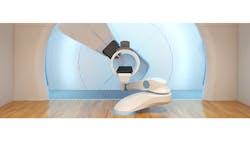Superconducting Coils Spur Advances in Proton Beam Therapy
For many different types of cancers among patients in various age groups, proton beam radiotherapy treatment (PBRT) is a desirable alternative to other types of radiation therapy. In PBRT, synchrocyclotrons, cyclotrons, isochronous cyclotrons, synchrotrons, and other proton accelerators release high-energy proton beams to radiate cancerous tumors. A proton beam can be directly aimed at a tumor, sparing healthy surrounding tissue from radiation.
With only 14 clinics in the U.S., PBRT is not available to all who qualify. For more than 10 years, scientists at MIT’s Plasma Science and Fusion Center (PSFC) have been researching new synchrocyclotron designs and collaborating with ProNova Solutions to lower PBRT-machine costs in cancer-treating clinics around the world.
In 2008, a team at MIT’s Plasma Science and Fusion Center designed a lightweight and compact synchrocyclotron by replacing the copper electromagnetic coils with superconducting varieties. Superconductive coils are cooled to low temperatures in order to reduce the resistivity of the material. They allow for smaller coils with less turns to generate higher magnetic fields, and can decrease the overall weight of an accelerator.
The new design could be placed directly on the gantry head that directs the proton beam at tumors. MIT’s synchrocyclotron gantry design replaces the old setup—the synchrocyclotron’s large size typically requires a separate room from the gantry and patient.
Now, the PSFC team looks to further reduce the size and weight of the gantry synchrocyclotrons by eliminating heavy iron elements. The superconductors will replace an iron pole in the center of the acceleration gap, which enhances the static magnetic field and keeps the protons moving in a spiral in the acceleration plane. Superconducting coils will also replace the iron yoke that contains the internal magnetic field and protects outside equipment.
Iron reaches magnetic saturation at about 2 Tesla. By replacing iron with superconductive electromagnets, the team can reach higher magnetic fields with a lower power supply. The design will also provide more control over beam intensity, which can be directly controlled by changing the current supplied to the coils. This will allow doctors to increase or decrease the intensity to correlate with the tumor’s different depths and densities.
The PSFC has other expectations for the development and improvement of proton accelerators for cancer treatment. By increasing the magnetic field without restoring to a high-voltage supply, the team hopes to be able to accelerate other heavier ions to high speeds. For example, carbon ions may be more effective for cancer treatment than light protons.
About the Author
Leah Scully
Associate Content Producer
Leah Scully is a graduate of The College of New Jersey. She has a BS degree in Biomedical Engineering with a mechanical specialization. Leah is responsible for Machine Design’s news items that cover industry trends, research, and applied science and engineering, along with product galleries. Visit her on Facebook, or view her profile on LinkedIn.
